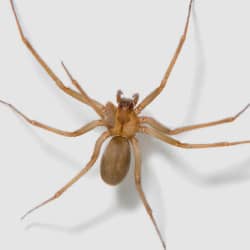There are many spiders that call Nashville their home, but most will only leave a red welt on your skin. If you see a distinct web in the corner of your house, or in the eaves of your deck, have no fear, these are the work of an orb spider, or house spider. But if you see a web that is haphazard in construction, or looks as if it is pouring down from a crack, a poisonous spider could be living in your home.
Brown Recluse
 This thin, brown spider is one fourth to a half inch long, with slender legs and a violin marking on its back. Some confuse this spider with a wolf spider, because of the brown coloring, but a wolf spider has thicker legs, is bigger, and has more hair than a brown recluse.
This thin, brown spider is one fourth to a half inch long, with slender legs and a violin marking on its back. Some confuse this spider with a wolf spider, because of the brown coloring, but a wolf spider has thicker legs, is bigger, and has more hair than a brown recluse.
It isn't a coincidence that this spider has the word recluse in its name. It is not interested in sharing your home. They like dark and undisturbed areas, like a box, a drawer full of seldom used clothing, and a stack of stored paper products. It is common to find a brown recluse hiding in shoes, so be careful to shake your shoes out before putting them on.
Brown recluse spiders do not feed on people. They feed on small bugs like roaches and crickets. The majority of brown recluse bites reported are the result of a victim bringing this spider in contact with their skin. Shaking clothing out is a good preventative measure, especially if the clothing has been laying on the floor.
The web of a brown recluse looks like a tangled mess, tucked away in a corner or crack. This is because the brown recluse doesn't use their web to catch bugs. They use it as a means of retreat.
Symptoms of a brown recluse bite can be lesions and ulcers in the infected area. And these necrotic patches can leave scarring.
Black Widow
 Glossy, with a jet black shell, the black widow can be distinguished by the hour glass shape on the underside of its abdomen. It has long, thin black legs that look like spikes at the end, and can grow to be one and a half to one and three eighths inches long.
Glossy, with a jet black shell, the black widow can be distinguished by the hour glass shape on the underside of its abdomen. It has long, thin black legs that look like spikes at the end, and can grow to be one and a half to one and three eighths inches long.
Black widows do not prefer to be around humans. They will generally find their way into garages, attic crawl spaces, and cellars. If they happen to find their way into the main living areas, they may hide in a shoe or discarded clothing. Shake shoes and clothing to protect against this spider, just as you would the brown recluse.
Though the web of the black widow is tangled and at ground level--like the web of a brown recluse--it has a flat, planar look, because the black widow uses it to catch crawling bugs. If you are wondering if the web you've stumbled upon is a black widow web, you can usually confirm it by finding this spider hanging upside down in the middle.
Symptoms of a black widow bite include: fever, sweating, increased blood pressure, and nausea, usually accompanied by severe pain. The poison administered by a black widow is not generally fatal, as long as medical attention is sought quickly.
What do I do if I find a black widow or brown recluse.
Contact a professional to have your home inspected. They can advise you on exclusion methods, and set you up for a treatment plan. These are not spiders you want to ever have in your house. Be sure to take appropriate action at the first sign of poisonous spiders getting into your house. A few red welts is one thing, but the damage a brown recluse or black widow can do to you or your children just isn't worth it.
 1042 Reviews
1042 Reviews